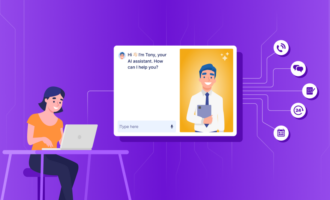Key Takeaways
- Conversational AI enables human-like conversations using machine learning and natural language processing.
- Tools like chatbots, voice assistants, and AI copilots are all types of conversational AI.
- Conversational AI can handle both text and voice interactions.
- AI virtual assistants can support customer service, HR, IT, and more.
- Future trends include emotional intelligence, voice accuracy, and multilingual capabilities.
- Jotform AI Agents help businesses build AI chat or phone agents in minutes.
Clear communication benefits everyone. A simple conversation between two parties can usually resolve issues, answer questions, and shed light on a subject by providing additional details. But having one-to-one conversations at scale can be difficult for larger businesses. That’s where conversational AI comes in.
Conversational AI allows organizations to talk with people via artificial intelligence platforms. For the most part, such conversations have proven to be productive, as 97 percent of executives say that conversational AI technology has positively influenced user satisfaction. It has also enhanced productivity and reduced operational costs.
Considering it for your own business? You’re in the right place. In this article, we dive into the details of conversational AI, including what it is, how it works, and how it can impact your business, employees, and customers.
What is conversational AI?
Conversational AI is an artificial intelligence tool that uses machine learning (ML), natural language processing (NLP), and other AI technologies to enable humans to talk with it. Via an easy-to-use interface, users can ask questions or provide information by typing or speaking to the tool. Conversational AI is used in many different areas of business, such as customer service and support, training, and administration.
Conversational AI solutions facilitate human-like conversations. In fact, with the best solutions, it’s difficult for users to distinguish whether they are talking to an AI tool or a human representative. The goal for any conversational AI tool is to carry out smooth, natural-sounding conversations in which users feel heard, get the information they seek, and leave feeling satisfied.
There are several different types of conversational AI technologies, such as chatbots, voice recognition solutions, and AI virtual agents. Although different conversational AI tools facilitate different types of tasks, they are all designed to conduct human-like conversations with users.
Build Your Custom AI Agent in Minutes
How does conversational AI work?
Two of the key technologies that power conversational AI are machine learning and natural language processing.
Machine learning refers to the field of study that uses algorithms to teach computers how to learn from data. Thanks to machine learning concepts, AI tools can learn from each user interaction and improve their performance every time they engage with someone.
Natural language processing is the technology that enables the tool to “understand” human language, then interpret it in order to provide a response.
Conversational AI tools that support voice interactions (rather than just text-based interactions) also use a third type of advanced technology called speech recognition. This technology converts spoken language into a written format, making it possible for computer systems to interpret the words and respond.
The process of interacting with an AI talk bot may seem simple, but there is actually a lot happening behind the scenes. Here are the main steps that occur throughout the course of a chat on AI:
- Input processing: Initially, the conversational AI tool receives input from a user through either text or speech. For example, someone visiting an online store might type a question into a website chatbot, such as “Can I find out when my order will arrive?”
- Natural language understanding (NLU): Once the conversational AI tool has the input, it uses natural language processing to interpret what the user has said. It determines the user’s intent and identifies key information within the interaction. In this case, the AI tool determines that the user wants a shipping status check for their recent order.
- Dialogue management: Next, the conversational AI tool decides how to respond. In some cases, it may need to ask the user for more information before it can generate an answer.
- Natural language generation (NLG): In this step, the AI tool formulates a response to the query. For example, it may respond with something like, “Sure, I’d love to help you. Can you please provide me with your order number?”
- Output generation: Finally, the conversational AI tool conveys the answer to the user. If it is capable of talking, AI will speak the response aloud. If it does not talk, AI might simply type out a written response. After this step, the process starts again as the user continues the conversation.
What’s the difference between chatbots and conversational AI?
Chatbots are a type of conversational AI tool, but they lack the sophistication of other conversational AI solutions.
Some chatbots are rule-based and follow pre-programmed scripts. These are best for very simple question-and-answer conversations. They are not able to handle more complex or multi-phrase questions.
Other chatbots have more advanced functionality and can conduct sophisticated, human-like conversations with users. These are often used in customer service functions, such as on a website or a social media app.
Conversational AI as a whole, however, goes well beyond chatbots and includes tools such as voice assistants and copilots. Voice assistants, like Amazon’s Alexa, can listen to voice commands from users, then complete simple actions and provide spoken responses. Copilots, on the other hand, are integrated into business systems and provide assistance for a wide range of specific administrative tasks, from enhancing lines of code to generating analytics reports.
Another type of conversational AI tool is the voice recognition system, which can convert spoken language into text to control a user interface. A good example of this is a voice-activated GPS system found in a car, which enables the driver to use it hands-free.
Chatbots are just one form of conversational AI. But which is the right solution for you? Consider the functionality of the various tools and the needs of your business. For example, while chatbots are great at answering common questions, they can’t fill the role of a copilot for administration. And while they may be simplistic by comparison, chatbots can still provide a lot of value in the realm of customer service and support.
Who uses conversational AI?
Conversational AI supports many industries — from e-commerce and human resources to education and healthcare — by enhancing communication and productivity. The best conversational AI tools help organizations communicate effectively with users at scale while also completing both administrative and critical tasks.
Here are some examples of how conversational AI is used within different industries:
Customer service and support
Customer service is one of the primary areas where conversational AI is used. Whether they write or talk, AI chatbots frequently serve as frontline workers, answering common questions and de-escalating issues. Many conversational AI tools can also triage customers and assign a human representative if the conversation warrants one.
Jotform’s Customer Service and Support AI Agents have a customer service solution that allows your business to provide helpful information to users.
E-commerce
Prospects and customers often have questions about products, shipping logistics, and orders when shopping online. These types of inquiries are perfect for conversational AI solutions. In addition to helping customers with frequently asked questions, AI can also support them in filling out payment forms.
Jotform’s AI agents are great conversational AI tools that can support many e-commerce processes.
Human resources (HR) and IT
Conversational AI tools are often used for external communication, but people within an organization — the employees — can greatly benefit from these tools as well. Whether it’s through help-desk tools or FAQs for employee handbooks, conversational AI can enhance both IT and HR processes.
Jotform’s Human Resources AI Agents and IT & Workplace AI Agents provide conversational AI tools designed to assist employees, enhancing both productivity and overall satisfaction.
Healthcare
Many administrative tasks within healthcare can benefit from a conversational AI tool, from appointment scheduling and payments to claims handling and even patient care management.
Repetitive and routine administrative tasks in healthcare are automated by Jotform’s Healthcare & Wellness AI Agents, reducing employee overwhelm and enhancing overall efficiency.
Education
Conversational AI is changing the way students learn. These helpful tools are a great way to provide students with AI tutors that can answer questions about the material they are learning. AI tools can support educational institutions on the administrative side as well, routing calls, scheduling appointments, and handling FAQs.
Jotform’s Education AI Agents are transforming education by offering AI tutors to help students with their learning while simplifying administrative tasks like managing communications and organizing appointments.
Future trends in conversational AI
Conversational AI is only in its infancy, so expect to see considerable advancement in the months and years to come.
One of the biggest emerging trends will be more multi-lingual support, with seamless translation for users. Because many businesses have global audiences, using conversational AI tools to communicate with prospects and customers will help break down language barriers.
Another future trend is enhanced emotional intelligence, which will greatly improve the quality of human-AI interactions. While AI will never be able to experience emotion, it will get better at identifying emotional situations and responding with emotional language. This will be particularly handy in customer service situations when customers are upset about a product or service issue.
Voice-based conversational AI solutions will also improve in the future, and as a result, talking to AI will become more commonplace. Advanced tools are already getting better at recognizing voice commands, even in noisy surroundings. This technology will also become better at recognizing speech characterized by strong accents.
The industry will also see more user-friendly conversational AI tools that don’t require any coding to customize. This advancement will make it even easier for organizations to train their own AI tools on their business processes, streamlining workflows for both employees and customers.
The overall impact of these future trends will be incredibly positive for customers, employees, and businesses alike. Some users don’t quite know how to talk to AI or feel nervous when talking to an AI tool. But the advancements within conversational AI technology will further streamline the conversation flow and make it seem even more natural.
Jotform AI Agents: The future is here
Jotform AI Agents allow organizations to have dynamic conversational experiences with their customers. Without writing a single line of code, your business can use these agents to answer customer queries and provide basic business information, as well as enhance internal workflows.
You can create a Jotform AI agent in three easy steps:
- Build the foundation of your AI agent by choosing from several options: start from scratch, build a form, use a template, or clone yourself.
- Train the AI agent using documents or websites from your business. This will ensure your AI agent understands your processes and requirements.
- Customize the AI agent using the Agent Builder tool. This way, the AI agent fits your unique business needs, collecting important data from users.
Jotform offers a comprehensive Jotform AI Agents directory, which includes thousands of ready-to-customize AI agents.
The Hospice Care Coordinator AI Agent, for example, supports relatives in filling out necessary administrative forms and streamlining check-in processes during highly emotional times.
The Real Estate Consultant AI Agent guides homebuyers through property searches. And the School Administrator AI Agent supports parent communication, helping administrators develop a strong partnership between parents and their school communities.
The Jotform AI Agent directory covers dozens of categories, including customer service, e-commerce, marketing, wellness, and many more. Users can chat on AI forms or with the AI agent directly, getting the information they need quickly and efficiently.
Best of all, Jotform AI Agents have a free plan, so you can get started right away!
FAQs about conversational AI
What’s the name of the technology that uses conversational AI?
Many technology tools use conversational AI, such as website and social media chatbots, voice assistants, copilots, and voice recognition systems. These tools have completely different functions, but they all have similar foundational technology like machine learning and natural language processing.
How do you talk to AI for maximum effectiveness?
In order to get the most out of your conversational AI experience, it’s best to be clear and concise. Use short, direct sentences. Offer context if needed. And whenever possible, limit the interaction to one question at a time.
Is conversational AI safe for businesses?
Not all conversational AI tools are built according to the same guidelines. To ensure the safety of their data, businesses must understand the privacy and security implications associated with using specific conversational AI tools.
Photo by: shurkin_son










































































Send Comment: